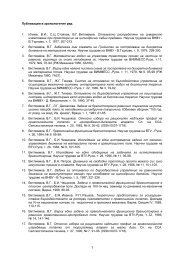Erasmus ECTS Information Package
Erasmus ECTS Information Package
Erasmus ECTS Information Package
Create successful ePaper yourself
Turn your PDF publications into a flip-book with our unique Google optimized e-Paper software.
<strong>Erasmus</strong> <strong>ECTS</strong> <strong>Information</strong> <strong>Package</strong><br />
Faculty of EEEA<br />
3130 Wireless Technologies for Data Transfer<br />
<strong>ECTS</strong> credits: 5<br />
Weekly classes: 2lec+0sem+0labs+2ps+1ca<br />
Assessment: exam<br />
Type of exam: written<br />
Department involved:<br />
Department of Telecommunications<br />
Faculty of Electrical Engineering, Electronics and Automation<br />
Lecturers:<br />
Prof. Mihail Petkov Iliev, MEng, PhD, Dept. of Telecommunications, tel.: 888 673, 888 457,<br />
E-mail: miliev@ecs.uni-ruse.bg<br />
Assistant Professor Plamen Zlatkov Zahariev, MEng, PhD, Dept. of Telecommunications, tel.: 888 663,<br />
E-mail: pzahariev@uni-ruse.bg<br />
Abstract:<br />
The Wireless Technologies for Data Transfer course aims to present the students with knowledge of different<br />
topologies and standards of wireless computer communication networks. It forms skills for independent solving of<br />
technical tasks for designing wireless networks and selecting passive and active equipment. Course prerequisites<br />
include Digital Television, Communication Networks and Terminals and Data and Computer Communications.<br />
Course content:<br />
The course topics are grouped in two principal directions: Wireless Technologies and Planning of a Wireless<br />
Network. In the first thematic direction, students are introduced to different topologies of wireless networks and<br />
different types of wireless equipment. Students are introduced to the 802.11x family standards for wireless<br />
communications and the WiMAX standard. In the second thematic direction, students prepare a plan for<br />
constructing a wireless network, prepare the address plan of the network nodes and select the passive and active<br />
equipment. An economic evaluation of the entire project is required as well.<br />
Teaching and assessment:<br />
Lecture topics enable the students to get acquainted with the main theoretic issues of wireless data transfers<br />
before doing the practical exercises. Students investigate the main characteristics of wireless networks at different<br />
standards, using the available laboratory installations and measurement instruments. Lectures discuss mainly the<br />
principles of wireless data transfers and wireless networks, while practical exercises focus on the main<br />
characteristics of networks.<br />
3132 Course project on Communication Networks and Systems<br />
<strong>ECTS</strong> credits: 2<br />
Weekly classes: 0lec+0sem+0labs+0ps+3cp<br />
Assessment: defence<br />
Type of exam: oral<br />
Department involved:<br />
Department of Telecommunications<br />
Faculty of Electrical Engineering, Electronics and Automation<br />
Lecturers:<br />
Principal Assistant Professor Georgi Valentinov Hristov, MEng, PhD, Dept. of Telecommunications tel.: 888 663,<br />
E-mail: ghristov@uni-ruse.bg<br />
Assistant Professor Plamen Zlatkov Zahariev, MEng, PhD, Dept. of Telecommunications, tel.: 888 663,<br />
E-mail: pzahariev@uni-ruse.bg<br />
Abstract:<br />
The project on Communication Networks and Systems aims at improving the knowledge of the students of the<br />
perceptual matter of computer communication networks. It forms skills for independent solving of engineering<br />
tasks such as structured cabling, selecting passive equipment and configuring active equipment. The course<br />
project uses the knowledge acquired in the subjects Communication Networks and Systems, Data Transmission<br />
and Computer Communications and Telegraphic Project Management.<br />
Course content:<br />
The subjects of the course projects are unified in one principle direction which is “Planning of a network using<br />
structured cabling and selection of passive and active equipment“.<br />
In the thematic direction, students prepare a plan for structured cabling using a given construction scheme,<br />
prepare address plan for the network nodes and select the passive and active equipment. An economic evaluation<br />
of the entire project is required as well.<br />
Teaching and assessment:<br />
At the beginning of the term each student receives an individual task. Students present intermediate results and<br />
receive instructions for their future work weekly. The project is realized independently by the students.<br />
The volume of the final version of the project is between 10 and 20 pages and consists of block schemes, principle<br />
diagrams and engineering computation, as well as an economic evaluation of the project.<br />
205
















